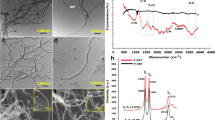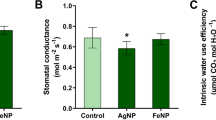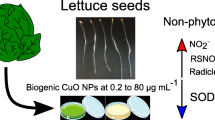Abstract
Carbon nanomaterials released into the environment exert extremely variable effects on living organisms. In this study, we used soybean (Glycine max) to investigate early responses to seed exposure to multi-walled carbon nanotubes (MWCNTs, outer diameter 20–70 nm, inner diameter 5–10 nm, length of >2 μm). Soybean seeds were imbibed with deionised water (control) or MWCNT suspension (1000 mg L−1) and were analysed for MWCNT contamination using light microscopy. The seedlings vitality status was evaluated by staining with triphenyltetrazolium chloride and measurement of oxidative stress indicators in the root tissue. Micronutrient (Zn, Mn, Cu) availability in different seedling organs was assessed and the effects of antioxidants, and micronutrient supplementation was investigated. Oxidative stress induction by MWCNTs was detectable in radicle tips, coincided with MWCNTs accumulation and was reverted by external application of proline as antioxidant and micronutrients (Zn, Cu, Mn) as cofactors for various enzymes involved in oxidative stress defence. Accordingly, SOD activity increased after Zn supplementation. During germination, the MWCNT treatments reduced Zn translocation from the cotyledons to the seedling and MWCNTs exhibited adsorption potential for Zn and Cu, which may be involved in internal micronutrients immobilisation. This study demonstrates for the first time that MWCNT phytotoxicity is linked with oxidative stress-related disturbances of micronutrient homeostasis.





Similar content being viewed by others
References
Ahmad I, Ahmad TKA, Basra SMA, Hasnain Z, Ali A (2012) Effect of seed priming with ascorbic acid, salicylic acid and hydrogen peroxide on emergence, vigor and antioxidant activities of maize. Afr J Biotechnol 11:1127–1137
Beauchamp C, Fridovich I (1971) Superoxide dismutase: improved assays and an assay applicable to acrylamide gels. Anal Biochem 44:276–287
Begum P, Fugetsu B (2012) Phytotoxicity of multi-walled carbon nanotubes on red spinach (Amaranthus tricolor L) and the role of ascorbic acid as an antioxidant. J Hazard Mater 243:212–222
Begum P, Ikhtiari R, Fugetsu B, Matsuoka M, Akasaka T, Watari F (2012) Phytotoxicity of multi-walled carbon nanotubes assessed by selected plant species in the seedling stage. Appl Surf Sci 262:120–124
Broadley M, Brown P, Cakmak I, Rengel Z, Zhao F (2012) Function of nutrients: micronutrients. In: Marschner H, Marschner P (eds) Marschner’s mineral nutrition of higher plants, 3rd edn. Academic Press, London, Waltham, pp 191–248
Burnell J (1988) The biochemistry of manganese in plants. In: Graham RD, Hannam RJ, Uren NJ (eds) Manganese in soil and plants. Kluwer Academic Publishers, Dordrecht, pp 125–137
Cakmak I, Marschner H, Bangerth F (1989) Effect of zinc nutritional status on growth, protein metabolism and levels of indole-3-acetic acid and other phytohormones in bean (Phaseolus vulgaris L.). J Exp Bot 40:405–412
Cakmak I, Marschner H (1988a) Enhanced superoxide radical production in roots of zinc-deficient plants. J Exp Bot 39:1449–1460
Cakmak I, Marschner H (1988b) Increase in membrane permeability and exudation in roots of zinc deficient plants. J Plant Physiol 132:356–361
Chachalis D, Smith ML (2001) Seed soaking damage in some grain legumes. J New Seeds 2:27–36
Cho H, Wepasnick K, Smith BA, Bangash FK, Fairbrother DH, Ball WP (2010) Sorption of aqueous Zn [II] and Cd [II] by multiwall carbon nanotubes: the relative roles of oxygen-containing functional groups and graphenic carbon. Langmuir 26:967–981
Comas LH, Eissenstat DM, Lakso AN (2000) Assessing root death and root system dynamics in a study of grape canopy pruning. New Phytol 147:171–178
Cvitanich C, Przybyłowicz WJ, Mesjasz-Przybyłowicz J, Blair MW, Jensen EØ, Stougaard J (2009) Iron, zinc, and manganese distribution in mature soybean seeds. The Proceedings of the International Plant Nutrition Colloquium XVI UC Davis. http://www.escholarship.org/uc/item/6mh1d8vv.
Dehghan G, Rezazadeh L, Habibi G (2011) Exogenous ascorbate improves antioxidant defense system and induces salinity tolerance in soybean seedlings. Acta Biol Szeged 55:261–264
Deng J, Shao Y, Gao N, Deng Y, Tan C, Zhou S, Hu X (2012) Multiwalled carbon nanotubes as adsorbents for removal of herbicide diuron from aqueous solution. Chem Eng J 193–194:339–347
Engels C, Kirkby E, White P (2012) Mineral nutrition, yield and source–sink relationships. In: Marschner H, Marschner P (eds) Marschner’s mineral nutrition of higher plants, 3rd edn. Academic Press, London, Waltham, pp 85–133
Ghodake G, Seo YD, Park D, Lee DS (2010) Phytotoxicity of carbon nanotubes assessed by Brassica juncea and Phaseolus mungo. J Nanoelectron Optoelectron 5:157–160
Ghosh M, Bhadra S, Adegoke A, Bandyopadhyay M, Mukherjee A (2015) MWCNT uptake in Allium cepa root cells induces cytotoxic and genotoxic responses and results in DNA hyper-methylation. Mutat Res Fundam Mol Mech Mutagen 774:49–58
Giraldo JP, Landry MP, Faltermeier SM, McNicholas TP, Iverson NM, Boghossian AA, Reuel NF, Hilmer AJ, Sen F, Brew JA, Strano MS (2014) Plant nanobionics approach to augment photosynthesis and biochemical sensing. Nat Mater 13:400–408
Gomes MP, Smedbol É, Carneiro MMLC, Garcia QS, Juneau P (2014) Reactive oxygen species and plant hormones. In: Ahmad P (ed) Oxidative damage to plants, Antioxidant networks and signaling, 1st edn. Academic, Amsterdam, pp 65–88
Hajiboland R, Hasani BD (2007) Responses of antioxidant defense capacity and photosynthesis of bean (Phaseolus vulgaris L.) plants to copper and manganese toxicity under different light intensities. Acta Biol Szeged 51:93–106
Hamada AM, Al-Hakimi ABM (2009) Hydroponic treatment with ascorbic acid decreases the effects of salinity injury in two soybean cultivars. Phyton—Annales Rei Botanicae 49:43–62
Han SG, Andrews R, Gairola CG (2010) Acute pulmonary response of mice to multi-wall carbon nanotubes. Inhal Toxicol 22(4):340–347
Hao Y, Yu F, Lv R, Ma C, Zhang Z, Rui Y, Liu L, Cao W, Xing B (2016) Carbon nanotubes filled with different ferromagnetic alloys affect the growth and development of Rice seedlings by changing the C:N ratio and plant hormones concentrations. PLoS One 11:e0157264
He H, Pham-Huy LS, Dramou P, Xiao D, Zuo P, Pham-Huy C (2013) Carbon nanotubes: applications in pharmacy and medicine. Biomed Res Int. doi:10.1155/2013/578290
Hsieh H, Wu R, Jafvert CT (2014) Light-independent reactive oxygen species (ROS) formation through electron transfer from carboxylated single-walled carbon nanotubes in water. Environ Sci Technol 48:11330–11336
Hu R, Fan C, Li H, Zhang Q, Fu Y (2009) Evaluation of putative reference genes for gene expression normalization in soybean by quantitative real-time RT-PCR. BMC Mol Biol 10:93
Hossain MA, Hoque MA, Burritt DJ, Fujita M (2014) Proline protects plants against abiotic oxidative stress: biochemical and molecular mechanisms. In: Ahmad P (ed) Oxidative damage to plants, Antioxidant networks and signaling, 1st edn. Academic, Amsterdam, pp 65–88
Ivanchenko MG, den Os D, Monshausen GB, Dubrovsky JG, Bednářová A, Krishnan N (2013) Auxin increases the hydrogen peroxide (H2O2) concentration in tomato (Solanum lycopersicum) root tips while inhibiting root growth. Ann Bot 112:1107–1116
Jian B, Liu B, Bi Y, Hou W, Wu C, Han T (2008) Validation of internal control for gene expression study in soybean by quantitative real-time PCR. BMC Mol Biol 9:59
Keller AA, McFerran S, Lazareva A, Suh S (2013) Global life cycle releases of engineered nanomaterials. J Nanopart Res 15:1692
Khodakovskaya M, Dervishi E, Mahmood M, Xu Y, Li Z, Watanabe F, Biris AS (2009) Carbon nanotubes are able to penetrate plant peed poat and dramatically affect seed germination and plant growth. ACS Nano 3:3221–3227
Khodakovskaya MV, de Silva K, Nedosekin DA, Dervishi E, Biris AS, Shashkov EV, Galanzha EI, Zharov VP (2011) Complex genetic, photothermal, and photoacoustic analysis of nanoparticle-plant interactions. Proc Natl Acad Sci 108:1028–1033
Kühn A (1971) Lectures on developmental physiology. Springer, Berlin, Heidelberg
Lahiani MH, Dervishi E, Chen J, Nima Z, Gaume A, Biris AS, Khodakovskaya MV (2013) Impact of carbon nanotube exposure to seeds of valuable crops. ACS Appl Mater Interfaces 5:7965–7973
Le DT, Aldrich DL, Valliyodan B, Watanabe Y, van Ha C, Nishiyama R, Guttikonda SK, Quach TN, Gutierrez-Gonzalez JJ, Tran LP, Nguyen HT (2012) Evaluation of candidate reference genes for normalization of quantitative RT-PCR in soybean tissues under various abiotic stress conditions. PLoS One 7:e46487
Lu C, Chiu H (2006) Adsorption of zinc (II) from water with purified carbon nanotubes. Chem Eng Sci 61:1138–1145
Luo M, Liu D, Zhao L, Han J, Liang Y, Wang P, Zhou Z (2014) A novel magnetic ionic liquid modified carbon nanotube for the simultaneous determination of aryloxyphenoxy-propionate herbicides and their metabolites in water. Anal Chim Acta 852:88–96
Ma G, Chen L (2014) Development of magnetic molecularly imprinted polymers based on carbon nanotubes—application for trace analysis of pyrethroids in fruit matrices. J Chromatogr A 1329:1–9
Miralles P, Johnson E, Church TL, Harris AT (2012) Multiwalled carbon nanotubes in alfalfa and wheat: toxicology and uptake. J R Soc Interface 9:3514–3527
Nagai H, Okazaki Y, Chew SH et al (2011) Diameter and rigidity of multiwalled carbon nanotubes are critical factors in mesothelial injury and carcinogenesis. PNAS 6(108):E1330–E1338
Ozden M, Demirel U, Kahraman A (2009) Effects of proline on antioxidant system in leaves of grapevine (Vitis vinifera L.) exposed to oxidative stress by H2O2. Sci Hortic 119:163–168
Poulsen SS, Saber AT, Williams A et al (2015) MWCNTs of different physicochemical properties cause similar inflammatory responses, but differences in transcriptional and histological markers of fibrosis in mouse lungs. Toxicol Appl Pharm 284(1):16–32
Powell AA, Oliveira MA, Matthews S (1986) The role of imbibition damage in determining the vigour of white and coloured seed lots of dwarf French beans (Phaseolus vulgaris). J Exp Bot 37:716–722
Rafique N, Raza SH, Qasim M, Iqbal N (2011) Pre-sowing application of ascorbic acid and salicylic acid to seed of pumpkin and seedling response to salt. Pak J Bo 43:2677–2682
Ramel F, Sulmon C, Bogard M, Couée I, Gouesbet G (2009) Differential patterns of reactive oxygen species and antioxidative mechanisms during atrazine injury and sucrose-induced tolerance in Arabidopsis thaliana plantlets. BMC Plant Biol 9:28
Rothen-Rutishauser B, Brown DM, Piallier-Boyles M, Kinloch IA, Windle AH, Gehr P, Stone V (2010) Relating the physicochemical characteristics and dispersion of multiwalled carbon nanotubes in different suspension media to their oxidative reactivity in vitro and inflammation in vivo. Nanotoxicology 4(3):331–342
Rydman EM, Ilves M, Koivisto AJ et al (2014) Inhalation of rod-like carbon nanotubes causes unconventional allergic airway inflammation. Part Fibre Toxicol 11:48
Sarlak N, Taherifar A, Salehi F (2014) Synthesis of nanopesticides by encapsulating pesticide nanoparticles using functionalized carbon nanotubes and application of new nanocomposite for plant disease treatment. J Agric Food Chem 62:4833–4838
Sharma A, Bhardwaj RD (2014) Effect of seed pre-treatment with varying concentrations of salicylic acid on antioxidant response of wheat seedlings. Indian J Plant Physiol 19:205–209
Sharma CS, Sarkar S, Periyakaruppan A, Barr J, Wise K, Thomas R, Wilson BL, Ramesh GT (2007) Single-walled carbon nanotubes induce oxidative stress in rat lung epithelial cells. J Nanosci Nanotechnol 7(7):2466–2472
Shvedova AA, Kisin ER, Murray AR, Gorelik O, Arepalli S, Castranova V, Young SH, Gao F, Tyurina YY, Oury TD, Kagan VE (2007) Vitamin E deficiency enhances pulmonary inflammatory response and oxidative stress induced by single-walled carbon nanotubes in C57BL/6 mice. Toxicol Appl Pharm 221(3):339–348
Srivastava A, Rao DP (2014) Enhancement of seed germination and plant growth of wheat, maize, peanut and garlic using multiwalled carbon nanotubes. European Chemical Bulletin 3:502–504
Srivastava RK, Pant AB, Kashyap MP, Kumar V, Lohani M, Jonas L, Rahman Q (2011) Multi-walled carbon nanotubes induce oxidative stress and apoptosis in human lung cancer cell line-A549. Nanotoxicology 5:195–207
Stampoulis D, Sinha SK, White JC (2009) Assay-dependent phytotoxicity of nanoparticles to plants. Environ Sci Technol 43:9473–9479
Straub D, Yang H, Liu Y, Tsap T, Ludewig U (2013) Root ethylene signalling is involved in Miscanthus sinensis growth promotion by the bacterial endophyte Herbaspirillum frisingense GSF30 T. J Exp Bot 64:4603–4615
Szőllősi R (2014) Superoxide dismutase (SOD) and abiotic stress tolerance in plants. In: Ahmad P (ed) Oxidative damage to plants, Antioxidant networks and signaling. Academic, Amsterdam, pp 89–129
Taiz L, Zeiger E (2007) Plant physiology, 4 th edn. Springer, Berlin, Heidelberg.
Tan X, Lin C, Fugetsu B (2009) Studies on toxicity of multi-walled carbon nanotubes on suspension rice cells. Carbon 47:3479–3487
The International Seed Testing Association (ISTA) (2015) Rules, 2015: 6-1–6-2
Thompson IA, Huber DM (2007) Manganese and plant disease. In: Datnoff LE, Elmer WH, Huber DM (eds) Mineral nutrition and plant disease. The American Phytopathological Society Press, St Paul MN, pp 139–153
Tiwari DK, Dasgupta-Schubert N, Villaseñor Cendejas LM, Villegas J, Carreto Montoya L, Borjas García SE (2014) Interfacing carbon nanotubes (CNT) with plants: enhancement of growth, water and ionic nutrient uptake in maize (Zea mays) and implications for nanoagriculture. Appl Nanosci 4:577–591
Villagarcia H, Dervishi E, de Silva K, Biris AS, Khodakovskaya MV (2012) Surface chemistry of carbon nanotubes impacts the growth and expression of water channel protein in tomato plants. Small 8:2328–2334
Wahid A, Farooq M, Siddique KHM (2014) Implications of oxidative stress for crop growth and productivity. In: Pessarakli M (ed) Handbook of plant and crop physiology, 3rd edn. CRC Press, Boca Raton, pp 549–556
Yan S, Zhao L, Li H, Zhang Q, Tan J, Huang M, He S, Li L (2013) Single-walled carbon nanotubes selectively influence maize root tissue development accompanied by the change in the related gene expression. J Hazard Mater 246-247:110–118
Yuan H, Hu S, Huang P, Song H, Wang K, Ruan J, He R, Cui D (2010) Single walled carbon nanotubes exhibit dual-phase regulation to exposed Arabidopsis mesophyll cells. Nanoscale Res Lett 297:787
Zaytseva O, Neumann G (2016a) Carbon nanomaterials: production, impact on plant development, agricultural and environmental applications. Chem Biol Technol Agric 3:16
Zaytseva O, Neumann G (2016b) Differential impact of multi-walled carbon nanotubes on germination and seedling development of Glycine max, Phaseolus vulgaris and Zea mays. European Chemical Bulletin 5:202–210
Zaytseva O, Neumann G (2016c) Phytotoxicity of carbon nanotubes is associated with disturbances of zinc homeostasis. European Chemical Bulletin 5:238–244
Zhang Q, Huang J, Zhao M, Qian W, Wei F (2011) Carbon nanotube mass production: principles and processes. ChemSusChem 4:864–889
Zheng X, Su Y, Chen Y, Wei Y, Li M, Huang H (2014) The effects of carbon nanotubes on nitrogen and phosphorus removal from real wastewater in the activated sludge system. RSC Adv 4:45953–45959
Acknowledgements
The author (OZ) is grateful to the Ministry of Science, Research and the Arts of Baden-Württemberg (Germany) and the Education, Audiovisual and Culture Executive Agency of the European Union for financial support. Furthermore, the authors would like to thank Angela Bernal (University of Hohenheim) for statistical consulting.
Author information
Authors and Affiliations
Corresponding author
Ethics declarations
Conflict of interest
The authors declare that they have no conflict of interest.
Rights and permissions
About this article
Cite this article
Zaytseva, O., Wang, Z. & Neumann, G. Phytotoxicity of carbon nanotubes in soybean as determined by interactions with micronutrients. J Nanopart Res 19, 29 (2017). https://doi.org/10.1007/s11051-016-3722-5
Received:
Accepted:
Published:
DOI: https://doi.org/10.1007/s11051-016-3722-5




